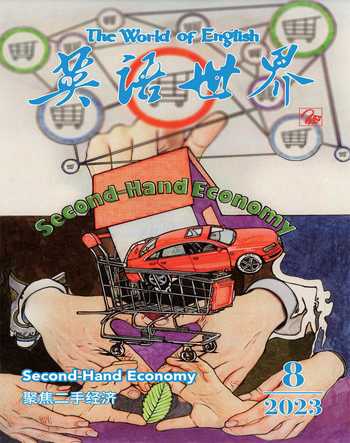A Kind of Blue1此藍非彼藍
李小華/譯
Environments can affect language—just not in the way you may think.
環境影響語言,但如何影響卻非你所想。
Everyone knows the Eskimos have dozens, if not hundreds, of words for snow because of their intimate knowledge of their environment. Except that everyone cannot “know” this, because knowledge requires a statement to be true. In fact, the Eskimo snow story is a factoid2, a word coined by Norman Mailer3 for a fun, roughly fact-shaped object that is not, in fact, a fact—in the same way a “spheroid” is not quite a sphere.
盡人皆知,愛斯基摩人對其生活的環境非常了解,于是他們就有幾十甚至幾百個表示“雪”的詞。只是并非人人都“了解”其中的緣由,因為了解的前提是陳述必須真實。事實上,愛斯基摩人雪的故事是factoid(仿真陳述)。這個詞是諾曼·梅勒創造的,指的是一個有趣的對象,貌似事實,實非事實——就像“球狀體”不完全是球體一樣。
The Eskimos (or Inuit4, as most prefer to be called) dont really have hundreds of words for snow because of their fine sense of its variety. Rather, they have a virtually infinite supply of words for everything, because of the nature of their languages. Inuit languages allow lexical roots to be strung together to make long, highly specific words, including some that might make an entire sentence in English. “Snow that has turned grey from being walked on repeatedly”, a noun phrase in English, might be a single word in Inuit. But the number of basic snow-related roots is not much larger than the number of snow words in English.
愛斯基摩人(又稱因紐特人,他們大多更喜歡這個稱呼)有數百種表示“雪”的說法,這其實并不是因為他們能精細感知各種各樣的雪。確切地講,無論說到什么東西,他們幾乎都有數不清的詞來指代,這是其語言特性使然。因紐特語能把詞根串連成表意極為精確的長單詞,其中有些用英語說可能得說完整的一句話。比如,在英語中“因反復踩踏而變成灰色的雪”是個名詞短語,而在因紐特語中可能只是一個單詞。但是,有關“雪”的基本詞根個數并不比英語中表示“雪”的單詞數多太多。
For many linguists, the Eskimo snow story has become an example of an embarrassing, exoticising fairy tale about an unfamiliar culture, passed round by those who know nothing of it. It is also the paradigmatic5 example of assuming a kind of mystical connection between language, land and culture—which falls apart6 under serious scrutiny.
許多語言學家認為,愛斯基摩人雪的故事儼然就是那種令人尷尬的異域童話,講的是陌生文化,由一些并不了解這種文化的人散播開來。這還是某種觀點的典型表現,即認為語言、地域和文化之間有某種神秘聯系——其實這種關聯經不起仔細推敲。
Today, efforts to draw links between language and the environment are more respectful. One linguist has observed that languages with certain rare consonants (called ejectives7) are more prevalent at high altitudes, perhaps because those are easier to pronounce in lower air pressure. Another team found that languages which use tones (ie, changes in pitch) in their vowels, to distinguish one word from another, are linked with humid climates. This is purportedly because humidity helps the vocal folds produce the tones. These causal relationships are not always accepted by other scholars.
如今,找出語言與環境之間關聯的努力更尊重現實。一位語言學家發現,帶有某些罕見輔音(稱為擠喉音)的語言在高海拔地區更為普遍,也許是因為氣壓較低時這些輔音更容易發出來。另一研究團隊發現,以元音聲調(即音高變化)區分單詞的語言與潮濕的氣候有聯系。據說,這是因為氣候潮濕利于聲帶發出各種聲調。上述因果關系并非總是得到其他學者的認同。
Recently, though, a large study of colour words around the world has found a clear link between geography and vocabulary. Colour is a classic case of a spectrum. There is no sharp break8 between, say, blue and teal9, and cultures divide the continuum10 in different ways. Some languages have just two colour-related words, for light and dark. A pair of linguists, Brent Berlin and Paul Kay11, wrote in the 1960s that if they have a third, it is almost always for red; a fourth and fifth are usually for green and yellow.
然而,最近有一項針對世界各地顏色詞的大型研究發現,地理環境和詞匯有著明確關聯。顏色是譜系的一個經典案例。比如,藍色和綠藍色無明顯差別,不同文化對這種漸變色彩的區分方式各異。有些語言只有兩個詞與顏色有關,分別代表淺色和深色。布倫特·伯林和保羅·凱這兩位語言學家在1960年代著書指出,語言中若有第三個顏色詞,那往往是紅色;若有第四個和第五個詞,那一般是綠色和黃色。
Blue comes only sixth in the Berlin-Kay schema12, elementary as it may seem. Besides the sky and sea, though, there are few blue things in nature, which may make the word less necessary; rarely does anyone say “look for a blue plant”, because these are uncommon. Many languages lump together blue and green, a chunk of the spectrum linguists call “grue”13.
根據柏林-凱的綱要,藍色僅位列第六,盡管它似乎是基礎色。然而,除了天空和海洋,自然界中幾乎沒有藍色的東西,這使得藍色這個詞也就不怎么有用。很少有人說“尋找一種藍色的植物”,因為藍色植物很少見。許多語言把藍色和綠色混為一談,語言學家稱色譜中的這一區域為“綠藍色”。
The new study breaks ground by finding that there is indeed a link between the use of grue words and the environment, specifically sunshine. Populations exposed to lots of sunlight are more likely to talk about “grue”, note Mathilde Josserand, Emma Meeussen, Asifa Majid and Dan Dediu14. One possible reason is that long-term exposure to ultraviolet light can cause changes in the retina that make it more difficult to distinguish blue from green.
此項新研究取得了突破,它發現表示綠藍色的詞,其使用與環境(具體指陽光)確有聯系。瑪蒂爾德·若斯朗、埃瑪·梅烏森、阿西法·馬吉德和丹·德迪烏指出,生活環境陽光充足的族群更有可能談及“綠藍色”。其中一個可能的原因是,長期接受紫外線照射,視網膜會發生種種變化,分辨綠色和藍色愈加困難。
The researchers tested a host of other theories to account for the presence of a “grue” term, and found a weaker but still interesting link to culture, rather than physiology. They discovered that larger populations were more likely to have a distinct “blue”. Population size, they speculate, is a reasonable proxy15 for cultural complexity—the kind, for instance, that would lead cultures to develop dyeing techniques, and thus create artificially blue objects.
研究人員對其他許多理論做了檢驗,以解釋表示“綠藍色”的詞存在的原因,他們找到了這些詞的產生和文化之間的聯系,盡管弱于同生理機能之間的聯系,但依然值得關注。研究人員發現,人口規模越大,出現單獨表示“藍色”的詞的可能性就越大。他們推測,人口規模是文化復雜性的可靠指標,比如說,這種復雜性會導致文化群體改進染色技術,進而造出人造藍色的物品。
This is the first study to test so many of these hypotheses to see which hold up16 best. That is an admirable approach, which reduces the chances of a coincidental finding, the type that pops up all the time when researchers scour databases looking for linked variables. (One such effort found a link between acacia trees and tonal languages, a connection rather difficult to explain.)
這是首次有研究檢驗如此多假設以確認哪個假設最能站得住腳。這種方法值得贊賞,可以降低偶然結果的概率——研究人員搜索數據庫尋找關聯變量時,總會出現這種偶然結果。(有這樣一次搜索就發現刺槐和聲調語言有聯系,但這種關聯難以解釋。)
The limitation is that the thing being tested (such as whether there is a distinct word for “blue”) must be quite simple, in order to compare widely varying languages. But the strength of this method is that it produces conclusions which, if you drop them into cocktail-party conversation, are more likely to be legitimate. Fun facts are only really so when they are, indeed, facts.
這種研究方式的局限在于,為了能比較相差懸殊的不同語言,檢驗的項目(如是否有確切表示“藍色”的詞)必須非常簡單。但這種方法的優勢是,如果在雞尾酒會與人交談時提及,所得結論合理的可能性更高。趣事為真,方為有趣。
(譯者為“《英語世界》杯”翻譯大賽獲獎者,單位:青島科技大學外國語學院)
1即指正文中的grue(綠藍色)。? 2梅勒于1973年在《瑪麗蓮》(Marilyn)一書中用fact加后綴-oid(像,類似于)構成的派生詞,指“在雜志或報紙上出現之前不存在的事實,所造事實與其說是謊言,不如說是操縱沉默的大多數人情感的產物”(facts which have no existence before appearing in a magazine or newspaper, creations which are not so much lies as a product to manipulate emotion in the Silent Majority)。? 3(1923—2007),美國小說家,代表作有《劊子手之歌》(The Executioners Song)、《裸者與死者》(The Naked and the Dead)等。? 4北極地區土著人,Inuit是他們的自稱,義為“人類”。Eskimo為舊稱,義為“生食者”,現趨棄用。
5 paradigmatic典范的。? 6 fall apart破碎,瓦解。? 7 ejective(語音學)擠喉音。
8 break突變,中斷。? 9 teal = teal blue(鳧藍,綠光暗藍色)。? 10 continuum(相鄰兩者相似但起首與末尾截然不同的)連續體。? 11這兩位學者在《基本顏色詞語:普遍性與進化論研究》(Basic Color Terms: Their Universality and Evolution, 1969)一書中,比較研究了近100種語言,概括出11種顏色詞語,按其包容關系依次為:黑(black)、白(white)、紅(red)、綠(green)、黃(yellow)、藍(blue)、棕(brown)、紫(purple)、橙(orange)、粉(pink)、灰(gray)。作者認為,這11種基本顏色詞(basic color terms)普遍存在于各種語言中,這是由于人類的視覺生理系統對某些顏色特別敏感,促使感性范疇在語言中反映出來。這一基本顏色詞普遍性原則表明,不同語言交流中顏色詞的語義存在著對應關系。? 12 schema (計劃或理論的)提要,綱要。
13由green和blue構成的縮合詞。? 14諸位學者于2021年9月在英國《科學報告》(Scientific Reports, Volume 11)上刊文“環境和文化塑造顏色詞匯和色覺遺傳”(Environment and culture shape both the colour lexicon and the genetics of colour perception),對藍色詞的產生因素進行了定量研究,認為理解語言間的差異必須依靠各語言的文化、生物和物理環境體系(variation in languages can only be understood in the context of their cultural, biological, and physical environments)。? 15 proxy(測算用的)替代物,指標。
16 hold up(論點、理論等)站得住腳,經受得住檢驗。

